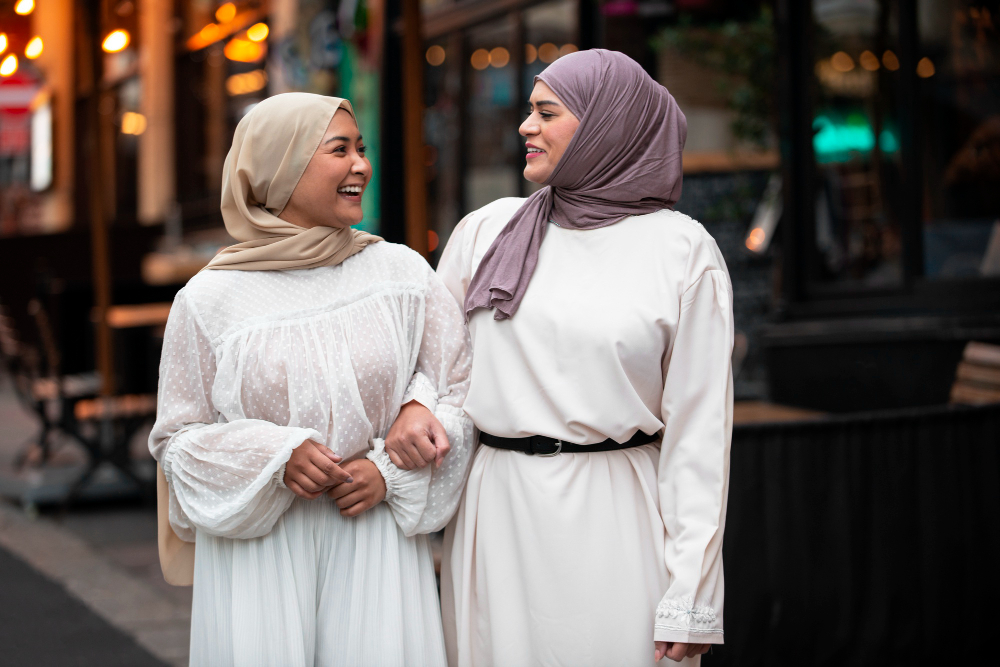The style of costumes in the Middle East has remained unchanged for centuries. This is partly due to the fact that Arab clothing evolved to suit the climate and served as protection from heat, dust and the scorching sun. Wearing traditional clothing was also accepted and supported by the vast majority of the region's inhabitants and remains a source of pride for its wearers to this day.
Arabic clothing is more than just a fashion statement, it is a way to express the cultural identity and heritage of various Arabic countries. With a wide variety of styles, colors, and types of embellishments, Arabic dress is a work of art in itself.
Traditional Arab Dress: Muslim Countries
Traditional Middle Eastern clothing is loose and covers or even wraps most of the body. The names of the garments vary from country to country, but the similarities between them are clear. Likewise, the materials they were and are still made of vary depending on what was available. In general, linen, cotton, and wool are the norm, but wealthy people have always worn clothing made of expensive silk-based fabrics. Some of the most famous of these materials originated with wealthy families, including baldachin, a richly decorated fabric with a gold thread warp made of silk, named after the city of Baghdad, and damask, named after Damascus (in Syria) - the place of origin of this richly patterned silk fabric.
A number of traditional garments were originally borrowed from the ancient cultures of the region, particularly Persia (Iran) and the eastern regions of India, Mongolia, and elsewhere. The Asian kaftan is one such example. It is an open, coat-like garment called a kandis in ancient Persia. The style, also widely worn in the cooler climates of Mongolia and China, spread westward and eventually became the fashionable dolman of the late Ottoman Empire.
The spread of the costume in the Middle East was largely due to the spread of Arab peoples and cultures. By the 6th century CE, the inhabitants of the Arabian Desert were living a stable rural life in the borderlands of Yemen, Syria and Iraq. In the interior, they were mostly Bedouin nomads who made their living by herding camels. By 750 CE, the Arab Empire stretched from Spain and Morocco in the west to the Caspian Sea and the Indus River in the east. The basic garments of the time were a loose shirt, chemise or robe, a draped cloak, baggy trousers and a headscarf or turban. Similar versions can still be seen on the streets of Cairo, Istanbul or Damascus.
Egyptian fellah (agricultural laborer)
The simple basic garment for both sexes was a loose long shirt, chemise or tunic, often with long sleeves. Over this, men wore robes or mantles of various types. The aba (or abaya) was of ancient origin and is mentioned in the Bible as the garment of the Hebrew prophets. It was traditionally made of thick, cream-coloured wool and decorated with brightly coloured stripes or embroidery. A voluminous overdress still worn in the Middle East and the Arab world is the djellaba, known as a jellaba in Tunisia, a jubba in Syria, a galibia in Egypt or a dishdasha in Algeria. The garment usually has wide, long sleeves and the long skirt may have slits at the sides. Some styles are open at the front, like a coat or kaftan.
The outer garments or cloaks sometimes included head coverings. These included the haik, an oblong piece of material (usually striped) that Arabs wrapped around their bodies and heads. The material measured approximately 18 by 6 feet (5.5 by 1.8 meters). A similar robe was the burnoose, a hooded garment also used for warmth.
Turkish woman
Loose, baggy trousers, traditional in the Middle East, as well as the Balkans and Anatolia, are still widely worn by both sexes.
The garment is believed to have originated in Persia, and it is assumed that the Arabs saw it there when they invaded the country in the 7th century. The trousers, called chalwar or salwar, depending on the country, were about 3 yards (2.75 meters) across at the waist and were drawn tightly with cords. The full leg portion was tied at each ankle. A wide belt was then girdled around the waist over the chalwar.
The garment was ideal for field work, as it allowed freedom of movement and protected the lumbar spine, especially when bending, from chills. For centuries, the garment was also worn by men in the army. Cotton is the usual material for work clothes, but fashionable women wear chalvar made of brocade or silk fabric over linen trousers.
Muslim woman in a chador
The custom of women covering themselves from head to toe, covering their faces when they go out in public. is an old tradition that predates Islam in Persia, Syria, and Anatolia. The Koran contains instructions that provide guidance on this matter, but not a strict ruling. However, some modern regimes insist on women strictly wearing this garment in public. The cloaks that women wear for this purpose are similar to each other and often have a mesh transition over the eye area through which women can look at the outside world. The most common names for this garment are burqa, chador, chadar, chadri, charshaf, and charchaf.
The characteristic male Arab headdress was the kaffiyeh. It is still worn today, although it can now be combined with a business suit. In essence, the kaffiyeh is a square of cotton, linen, wool or silk, plain or patterned, which is folded into a triangle and put on the head so that one point falls on each shoulder and the third on the back. It is held on the head by an agal (igal, egal) - a cord band decorated with beads or metal threads.
Footwear consisted of sandals, shoes or boots with slightly upturned toes.





Comments